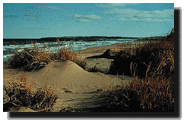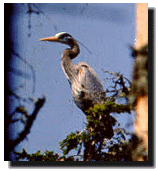











For well over one hundred years, the national parks system in Canada has played a vital role in preserving our country’s natural and cultural heritage. Prince Edward Island boasts one national park and several national historic sites. The national park’s mandate is as follows:
To commemorate and present places
which are significant examples of Canada’s cultural
and natural heritage in ways that encourage public
understanding, appreciation and enjoyment so as to leave
it unimpaired for future generations.
 In 1937, the
40-kilometre strip of sand dunes, ponds, marshes, red
sandstone cliffs, and Acadian forest on the Island’s
north shore was set aside to create the Prince Edward
Island National Park. The park is involved in protecting
many ecosystems and the indigenous flora and fauna found
within its boundaries. A prominent example of this is the
fragile dunes which rely on the marram grass root system
to hold them in place and protect the dunes from erosion.
Without the marram grass, the strong north shore winds
would carve the dunes, causing them to shift constantly
and rendering them unable to support vegetation or
wildlife.
In 1937, the
40-kilometre strip of sand dunes, ponds, marshes, red
sandstone cliffs, and Acadian forest on the Island’s
north shore was set aside to create the Prince Edward
Island National Park. The park is involved in protecting
many ecosystems and the indigenous flora and fauna found
within its boundaries. A prominent example of this is the
fragile dunes which rely on the marram grass root system
to hold them in place and protect the dunes from erosion.
Without the marram grass, the strong north shore winds
would carve the dunes, causing them to shift constantly
and rendering them unable to support vegetation or
wildlife.
The park is also fostering the
regeneration of abandoned fields and meadows by
establishing red pine plantations and implementing an
overall vegetation management plan. The diverse wetland
and woodland habitats are home to a variety of wildlife,
including deer mice, red fox, mink, muskrat, and snowshoe
hare. A symbol of the Prince Edward Island National Park,
the Great Blue Heron can be seen in shallow ponds, bays,
and marshes waiting for fish to swim their way. The heron
comes to the park and other Island estuaries in the early
spring after spending the winter season in South America
and the southern United States.
 Since
1982, the Prince Edward Island National Park has devoted
considerable energy to the preservation of the endangered
piping plover, a small shorebird that nests in flat sandy
areas. Scattered gravel and seashells provide so perfect
a camouflage that their nests are often unwittingly
disturbed by sunbathers and beachcombers. The 25 nesting
pairs in the Prince Edward Island National Park represent
approximately two percent of the world’s dwindling
piping plover population. For 16 years, the park’s
Plover Guardian Program has contributed to a noticeable
increase in chick survival.
Since
1982, the Prince Edward Island National Park has devoted
considerable energy to the preservation of the endangered
piping plover, a small shorebird that nests in flat sandy
areas. Scattered gravel and seashells provide so perfect
a camouflage that their nests are often unwittingly
disturbed by sunbathers and beachcombers. The 25 nesting
pairs in the Prince Edward Island National Park represent
approximately two percent of the world’s dwindling
piping plover population. For 16 years, the park’s
Plover Guardian Program has contributed to a noticeable
increase in chick survival.
A Prince Edward Island National Park experience can take
several forms. A wide range of interpretive activities
are scheduled throughout the summer months. Visitors can
also beach comb, sunbathe on the white sand shore, swim
in the Gulf of St. Lawrence, or walk one of eight hiking
trails, which feature interpretive signs, rest stops and
shelters along their winding paths through woodlands,
barachois, old farmhouses, a pioneer cemetery, sandy
dunes, red sandstone cliffs, and cultivated farmlands.
The Rustico Island area of the Park is a site of great
historical significance. Here, archaeologists have
discovered artifacts which date back to A.D.1400. Two of
the province’s oldest churches are also located
there. In addition, the national park incorporates Green
Gables House, a recreation of the farm that inspired Lucy
Maud Montgomery’s famous novel, Anne of Green
Gables. The grounds and farm outbuildings,
complemented by interpretive programs, portray rural
Island life of the nineteenth century.

National Historic
Sites | Scenic Heritage
Roads | Museums
and Historic Villages
Historic
Buildings and Churches | Monuments
to Our Past